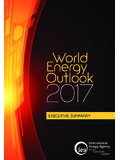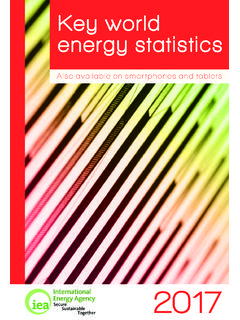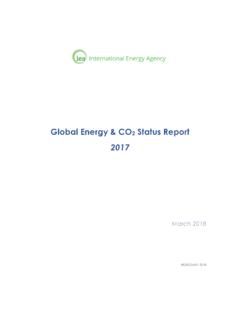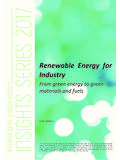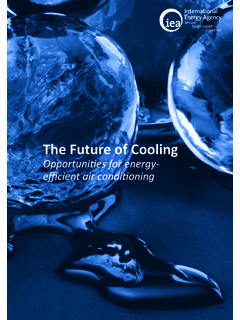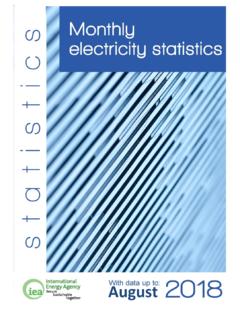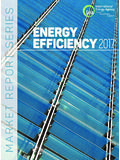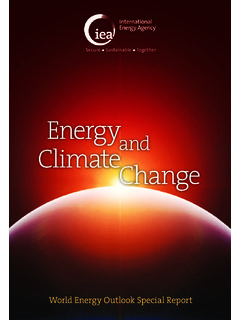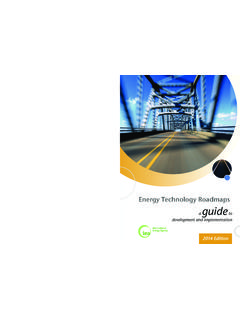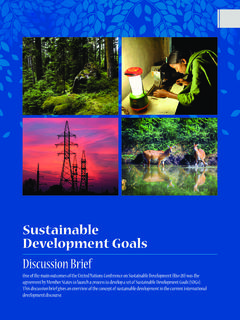Transcription of WOMEN IN CLEAN ENERGY - International Energy …
1 WOMENIN CLEANENERGYKNOWLEDGE, GAPS & OPPORTUNITIEST echnology Collaboration Programme on CLEAN ENERGY , Education and EmpowermentIEA MINISTERIAL MEETING SIDE EVENT, 7 November 20172 THE C3E TCP GOALSThe CLEAN ENERGY , Education and Empowerment (C3E) Programme was created in 2010 as an initiative of the CLEAN ENERGY Ministerial (CEM) to enhance International collaboration and promote the leadership and participation of WOMEN in the CLEAN ENERGY transformation. In 2017, a decision was taken to organise the C3E s activities as an IEA Technology Collaboration Programme (TCP). This provides a strong foundation to the work and provides additional visibility to the C3E TCP s work globally. As a TCP, C3E joins a network of 6 000 experts participating in the ENERGY Technology Network (ETN), which engages in ENERGY research and development, and can assist with the development of best practice sharing to support the goals of C3E.
2 The 38 TCPs operating today involve nearly 300 public and private organisations in 53 countries. The C3E TCP has four areas of focus:Data collection Career development Awards programmes Dialogue The C3E TCP will enable stakeholders from around the globe to gather scientific knowledge, share ideas, host events, and exchange views on how to increase knowledge about WOMEN in CLEAN ENERGY and implement concrete actions to improve diversity in the ENERGY sector. It was formally established as a TCP in June by founding members Canada, Italy and Sweden. Several additional countries are in the process of joining C3E. The C3E TCP offers broad visibility and leverages the high-level political engagement of ENERGY ministers. Each C3E TCP participating country is expected to take meaningful action to advance WOMEN in CLEAN ENERGY and close the gender gap in their own national in CLEAN energy4As the CLEAN ENERGY sector continues to grow and evolve, competitiveness relies on the ability to attract and retain a diverse pool of talent capable of bringing fresh perspectives.
3 Many countries have recognised the importance of harnessing all talent and closing the gender gap, noting that greater gender equity brings economic and social benefits to , the ENERGY industry remains one of the most gender imbalanced sectors. WOMEN make up substantially less than half of the workforce across the ENERGY sector and continue to be underrepresented in leadership positions. Closing the gender gap is not only a moral and social imperative, but makes good sense for business, as studies show that diverse organisations perform , there is only limited gender-disaggregated data for the CLEAN ENERGY sector and there is limited knowledge about how to make the sector more gender equal. To remedy this data gap and help advance WOMEN in this sector, the C3E TCP seeks to collect and develop consistent, reliable data measuring WOMEN s participation in CLEAN C3E TCP s founding participants, Canada, Italy and Sweden, are launching this effort by preparing this overview of the gender issue globally and in their respective countries, based on available THE STATE OF GENDER IN THE CLEAN ENERGY SECTOR WOMEN in CLEAN energy6 POWER AND INFLUENCEW omen are key drivers of innovative and inclusive solutions.
4 According to the United Nations (UN), there is established and growing evidence that WOMEN s leadership in political decision-making processes improves WOMEN are more likely to work across party lines through parliamentary WOMEN s caucuses even in the most politically combative environments and champion issues of gender one woman is a leader, it changes her. When more WOMEN are leaders, it changes politics and Bachelet, President of Chile A study by the European Institute for Gender Equality (EIGE), found that in 2011 WOMEN hold about of high-level decision-making positions in the environment, transport, and ENERGY sectors. The research also found that WOMEN s participation is higher in the environmental sector than in ENERGY and transport, and the same holds true for parliamentary committees on these of female ENERGY -related ministers in the European Union (2017)Share of female ENERGY -related ministers in the C3E TCP countries (1976-2017)Source: Data from EU elaborated by C3E Sources: Data compiled by the C3E TCP UN WOMEN , In Brief: WOMEN s Leadership and Political Inter-Parliamentary Union (2008), Equality in Politics: A Survey of Men and WOMEN in WIP/The World Bank, The Female Political Career, 2015.
5 6. USAID/IUCN, WOMEN at the Forefront of the CLEAN ENERGY Future, 2014. WOMEN s representation in ENERGY policy is limited, across all levels of leadership. In a 2013 analysis of 72 countries, only 4 countries (6%) worldwide had female ministers overseeing national ENERGY policies and Of the 39 countries invited to the 2017 IEA Ministerial, the percentage was still low (10%) with only 4 WOMEN in the top in CLEAN energy1. European Union, EU Who is Who: Official Directory of the European Union, Canada: Minister of Natural Resources Canada: 2 of 11 ministers have been female since department created in 1997; Minister of ENERGY , Mines and Resources (1976-1995): 2 of 12 ministers were female between 1976-1995; Minister of Environment and Climate Change Canada: 6 of 23 ministers have been female between 1976-2017; Italy: Ministry of Economic Development: 1 of 31; Ministry of Education, University and Research: 9 of 31; Ministry for the Environment, Territory and Sea: 2 of 31; Sweden: Minister of ENERGY : 4 of IRENA, Renewable ENERGY and Jobs Annual Review Woolley, A.
6 W et al. (2010), Evidence for a collective intelligence factor in the performance of human groups , Science Magazine, 29 October 2010, 330 (6004), pp. N11 Countries or the Next 11 Countries refers to a group of eleven countries Bangladesh, Egypt, Indonesia, Iran, Mexico, Nigeria, Pakistan, the Philippines, Turkey, South Korea, and Viet Nam which have emerging markets that could potentially become some of the world s largest conomies. Goldman Sachs (12 May 2015), N-11 Equity Portfolio ( brochures_and_sales_aids/fund_ ).10. Goldman Sachs (2008), Global Economics Paper No. 164: WOMEN Hold up Half the AND INFLUENCEW omen s leadership in the corporate sector results in improved business show that the number of WOMEN on boards across many sectors is minimal. WOMEN are also underrepresented in senior leadership roles in the ENERGY sector. The absence of WOMEN at the top means a loss of talent, ideas and innovation where they are needed the on a survey of 90 renewable ENERGY companies worldwide, WOMEN represented an average of 35% of the workforce (IRENA, 2016), a share greater than in the traditional ENERGY sector, but lower than in the broader economy.
7 There are currently million renewable jobs globally - a number that could rise to 24 million by 2030 (IRENA, 2016); WOMEN are essential to filling this demand, and can help support the growth of the CLEAN ENERGY sector as a major global economic driver. Ernst & Young s (EY) WOMEN in Power and Utilities (P&U) Index tracks the number of WOMEN in the boardrooms of the world s largest utilities in revenue terms. In 2016, WOMEN made up only 16% of P&U boards, a rise of just 1% over three years. At this rate, it would take as long as 42 years to reach a level of 30% WOMEN on boards, and 72 years to attain 40%.The study also highlights that having more WOMEN on boards makes good business sense and improves the bottom-line. Well-documented evidence shows the links between the presence of more WOMEN on the board and increased profitability, return on investment and in power and utilities index 20167%9%6%7%3%23%7%16%23%12%21%17%8%12%9 %LatinAmerica and CaribbeanEuropeCanada and the United StatesAfrica and Middle EastAsia and Paci cThismapis withoutprejudiceto thestatusof orsovereigntyoverany territory, to thedelimitationof International frontiersandboundaries,andto thenameof any territory, directorNon-executive directorSenior management teamShare of WOMEN on corporate boards of ENERGY companies (2014 and 2016)14%35%27%CanadaItalySwedenSources.
8 Data compiled by the C3E TCP study investigating more than 1 500 companies found that having more WOMEN on their board of directors led to more investment in renewable ENERGY and greater consideration of environmental risks in their financial decision making (McElhaney, 2012).7A study by the MIT Center for Collective Intelligence analysed group decision making and found that greater diversity, including more WOMEN , leads to better decision making. The study drew on the fact that WOMEN are sometimes stronger at reading non-verbal cues and ensuring that everyone s voice is the BRICS countries (Brazil, Russia, India, People s Republic of China and South Africa) and the next eleven countries9, narrowing the gender gap in employment could increase income per capita as much as 14% by 2010, and by 20% in 2030, according to research by Goldman Canada: Data from Osler, Hoskin and Harcourt s 2016 Diversity Disclosure Practices report.
9 Data is extracted from 130 ENERGY companies (oil and gas; utillties and pipelines; CLEAN technology) listed on the Toronto Stock Exchange (TSX) that are subject to the diversity disclosure requirements, ; Italy: The data for Italy refers to the most representative state-owned ENERGY companies (ENEL, ENI, GSE, TERNA, ACEA, A2A, HERA); Sweden: Swedish Companies Registration Office, Infotorg and Statistics Sweden (processed by the Swedish ENERGY Agency).More WOMEN = higher return on equity (ROE) for in CLEAN energyACADEMIA WOMEN IN SCIENCE, TECHNOLOGY, ENGINEERING AND MATH FIELDS (STEM)Attracting more WOMEN to pursue higher education in STEM fields will expand and diversify the pool of skills and talents and is crucial to boosting innovation in the make up substantially less than half of the workforce in STEM fields and across the CLEAN ENERGY sector. They are less likely to enrol in STEM education or take up technical positions due to biased views of gender Isolation, male-dominated work environments, ineffective executive feedback, and a lack of support are factors pushing WOMEN to leave science, engineering and technology C3E TCP seeks to both inspire more WOMEN to enter into CLEAN ENERGY careers and also to retain the current female CLEAN ENERGY workforce.
10 Without engaging WOMEN , countries are leaving half of the potential ENERGY workforce out of the talent pool, hampering the current and future STEM-driven economy and economic IRENA, Renewable ENERGY and Jobs Annual Review Sylvia Ann Hewlett and Laura Sherbin with Fabiola Dieudonn , Christina Fargnoli, and Catherine Fredman, (2014), Athena Factor : Accelerating Female Talent in Science, Engineering & Technology, Center for Talent : Data compiled by the C3E TCP 14. UNESCO Institute for Statistics (2015), UIS Fact Sheet: WOMEN in OECD (Italy and Sweden 2014, Canada 2013), Data related to science, mathematics and computing, and engineering, manufacturing and construction, Bachelor s or equivalent level (ISCED2011 level 6) and Master s or equivalent level (ISCED2011 level 7), #.Thismapis withoutprejudiceto thestatusof orsovereigntyoverany territory, to thedelimitationof International frontiersandboundaries,andto thenameof any territory, to 30% to 45% to 55% to 70% to 100%Data not availableGender gap in science: WOMEN as a share of total reserchers, 2013 or latest year available10 Sources: UNESCO Institute for Statistics, October 2015 and Elsevier of female graduates in STEM fields (2013 and 2014)CanadaItalySweden38%40%37%Prelimina ry data collected from C3E TCP countries confirm that, despite the high level of education of WOMEN in new technologies and science, the glass ceiling to career progression still exists.
